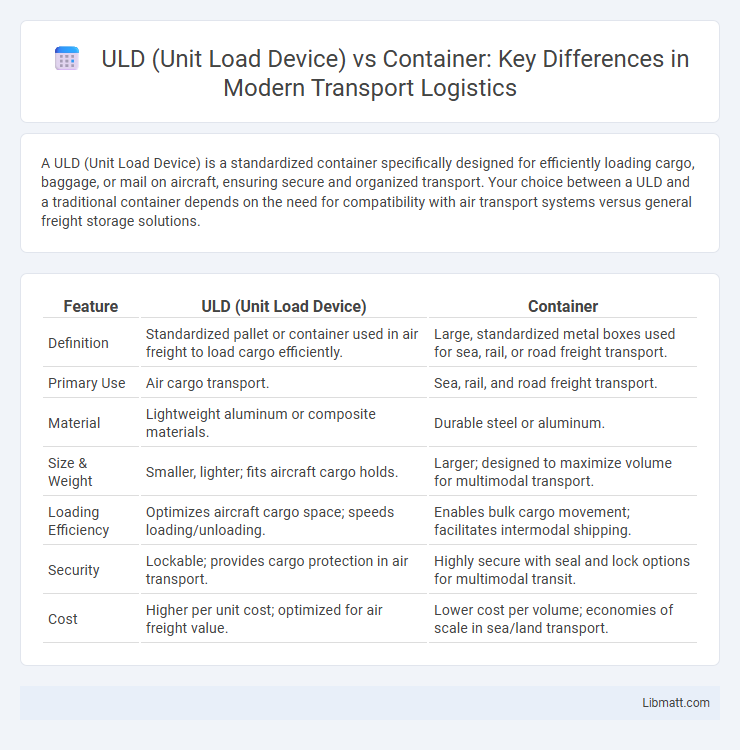A ULD (Unit Load Device) is a standardized container specifically designed for efficiently loading cargo, baggage, or mail on aircraft, ensuring secure and organized transport. Your choice between a ULD and a traditional container depends on the need for compatibility with air transport systems versus general freight storage solutions.
Table of Comparison
| Feature | ULD (Unit Load Device) | Container |
|---|---|---|
| Definition | Standardized pallet or container used in air freight to load cargo efficiently. | Large, standardized metal boxes used for sea, rail, or road freight transport. |
| Primary Use | Air cargo transport. | Sea, rail, and road freight transport. |
| Material | Lightweight aluminum or composite materials. | Durable steel or aluminum. |
| Size & Weight | Smaller, lighter; fits aircraft cargo holds. | Larger; designed to maximize volume for multimodal transport. |
| Loading Efficiency | Optimizes aircraft cargo space; speeds loading/unloading. | Enables bulk cargo movement; facilitates intermodal shipping. |
| Security | Lockable; provides cargo protection in air transport. | Highly secure with seal and lock options for multimodal transit. |
| Cost | Higher per unit cost; optimized for air freight value. | Lower cost per volume; economies of scale in sea/land transport. |
Introduction to ULDs and Containers
Unit Load Devices (ULDs) are specialized pallets or containers designed to efficiently transport cargo on aircraft, optimizing space and ensuring safety during air freight shipments. Containers, often referred to as air cargo containers or pods, are rigid, enclosed units that protect goods from damage and weather, available in various standardized sizes to fit different aircraft types. Both ULDs and containers enhance logistics by streamlining loading and unloading processes, reducing handling time, and improving cargo security in air transportation.
Definition: What is a ULD?
A Unit Load Device (ULD) is a specialized container or pallet used to securely load luggage, freight, and mail on wide-body aircraft and specific narrow-body aircraft. ULDs are designed to fit aircraft cargo bays efficiently, optimizing space and ensuring safe transportation by minimizing cargo movement during flight. Unlike standard shipping containers, ULDs are tailored for the aviation industry, combining lightweight materials with precise dimensions to meet airline specifications.
Definition: What is a Container?
A container is a standardized metal box used for the secure and efficient transport of cargo across multiple modes of transportation, including ships, trucks, and trains. Designed to withstand harsh conditions, containers facilitate easy loading, unloading, and stacking, optimizing space utilization and minimizing handling damage. Unlike Unit Load Devices (ULDs) tailored specifically for air cargo, containers are primarily used in maritime and intermodal freight logistics.
Types of ULDs in Aviation
Unit Load Devices (ULDs) in aviation include various types such as pallets, also called aircraft pallets or contour pallets, and containers, which are rigid or semi-rigid boxes designed to fit inside an aircraft's cargo hold. Common ULD containers include LDs (Load Devices) like LD3, LD6, and LD11, each tailored for different aircraft models and cargo volumes. Pallets often have nets or straps to secure the cargo, whereas containers provide enclosed protection, enhancing cargo safety and efficiency during air transport.
Types of Shipping Containers
Shipping containers primarily include dry containers, refrigerated containers, and open-top containers, each designed for specific cargo types and environmental conditions. Unit Load Devices (ULDs) are tailored for air freight, coming in various forms such as pallets and containers optimized for aircraft cargo holds. Understanding the distinct types of shipping containers and ULDs helps you select the most efficient and secure option for transporting your goods by sea or air.
Key Differences: ULD vs Container
ULDs (Unit Load Devices) are specially designed for air cargo, offering lightweight, durable structures that optimize space within aircraft by conforming to fuselage shapes, whereas containers primarily serve sea and land transport with heavier, standardized, rigid designs. ULDs facilitate faster loading and unloading through compatibility with aircraft systems, improving turnaround times, while containers emphasize protection and stackability for long-haul maritime or overland shipments. The choice between ULD and container depends on transport mode, cargo type, and logistical efficiency requirements, highlighting the importance of ULDs in air freight operations compared to containers' prominence in intermodal shipping.
Benefits of ULDs for Air Freight
ULDs (Unit Load Devices) provide significant benefits for air freight by maximizing cargo space efficiency and ensuring secure, standardized packaging that fits perfectly inside aircraft holds. Their lightweight design reduces overall shipment weight, lowering fuel consumption and shipping costs, while improving handling speed and minimizing damage risks during transit. By using ULDs, your air freight operations achieve enhanced safety, faster turnaround times, and better compliance with airline regulations, optimizing the entire supply chain process.
Advantages of Containers for Sea and Land Freight
Containers offer superior durability and weather resistance for sea and land freight, safeguarding goods during long transit periods and rough handling. Their standardized sizes enable seamless intermodal transport, improving efficiency by allowing easy transfer between ships, trucks, and trains without repacking. Large capacity and stackability of containers reduce transportation costs and optimize cargo space utilization compared to ULDs in maritime and overland logistics.
Cost Comparison: ULDs vs Containers
ULDs (Unit Load Devices) typically offer lower upfront costs than standard shipping containers due to their smaller size and specialized design for air cargo, reducing handling and fuel expenses for airlines. Containers incur higher initial investment and maintenance costs but provide superior durability and versatility for long-term use in multimodal transport. The cost-efficiency of ULDs versus containers depends largely on shipment volume, transport mode, and frequency of use in supply chain operations.
Choosing Between ULDs and Containers for Your Cargo
Choosing between ULDs and containers depends on your cargo type, volume, and shipping requirements. ULDs offer lightweight, standardized units specifically designed for airfreight, enhancing loading efficiency and protecting fragile goods, while containers provide robust, versatile options for sea freight and large shipments. Your decision should balance factors like transit mode, handling ease, and cargo protection needs to optimize transportation efficiency.
ULD (unit load device) vs container Infographic

 libmatt.com
libmatt.com